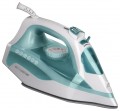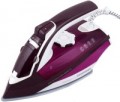Steam supply power
The steam supply power provided by an iron is essentially the amount of steam supplied by the device per minute. In most modern irons, the intensity of steaming can be adjusted, so this item usually indicates the maximum power value.
The more steam the iron supplies, the more intense the effect on the fabric, the more dense and rigid materials can be effectively smoothed out without resorting to a steam boost (see below). On the other hand, high performance significantly affects the price, dimensions and weight of the iron. Accordingly, it is worth choosing according to this indicator taking into account the planned method of application — especially since the full power of steam is far from always required, and in special cases the same steam boost can be used.
In travel and simple household irons, the productivity is about 15 – 30 g/min. More than 30 g/min corresponds to enhanced steaming, and the most advanced devices, mainly for professional use, are capable of producing 60 g/min or more (the so-called “turbo mode”).
Steam boost power
The steam power supplied by the iron in boost mode.
The steam power is the amount of steam the iron produces per minute. See above for more information on the general meaning of this parameter. And the steam boost mode is a mode of enhanced steaming, when the iron practically “shoots” with a boost of steam; "shot" is usually made by pressing a special button. Steam boost allows you to achieve an intense effect that is not available with conventional steaming; such an impact can be useful, for example, to smooth out heavily rumpled fabrics that would be difficult to deal with in other ways.
A steam boost of 100 g/min or more is said to be sufficient to handle most tough and "unruly" materials. And
models with a powerful steam boost from 200 g/min will definitely not leave even the most dense fabric rumpled. However, there are models with more modest indicators — they are quite suitable for those who need an iron for ordinary household ironing. Moreover, high power, usually, affects the cost. Do not forget about irons with a steam generator, where the performance values are higher, since the purpose of the iron is slightly different.
Water tank volume
The volume of the water tank installed in the iron.
The water from this container is used to generate steam when steaming fabrics. In modern models of irons, the tanks are made of transparent materials and are provided with a lid at the opening through which water is poured. As for capacity, a large volume, on the one hand, allows you to work longer without refilling, on the other hand, it significantly makes the entire device heavier. Therefore, in classic models, where the tank is located on the iron itself, the capacity is usually small — about 80 ml for travel and 300 ml for household models. But there are also
irons with a large water tank, in which the volume can reach 500 ml. But for advanced steam generators and ironing systems (see "Type"), the tank is made separately, and in such cases its volume can be 1 L, and for
models with a large tank, figures of more than 1.5 L are typical.
Features
—
Steam supply. The possibility of supplying steam to the place of ironing, directly through the soleplate. Steam is effective in smoothing wrinkles, serves various purposes, and offers a bactericidal effect. Contemporary irons commonly offer two steam supply methods: automatic, delivered at a consistent rate, and manual, activated through the "steam boost" mode—providing a brief and potent burst of steam at the touch of a button.
—
Vertical steaming. The ability to provide steam in a vertical position of the iron enables a convenient way to "refresh" and smooth clothes directly on the hanger. This proves especially practical for quickly eliminating wrinkles just before dressing and heading out, often surpassing the need for traditional ironing on the board.
—
Anti-drip system. An anti-drip feature is essential for preventing water droplets from escaping through the steam holes in the soleplate. Drops can result from iron malfunctions or insufficient temperature during steaming, where water fails to convert to steam in time. These droplets are undesirable as they may cause stains on fabric. Hence, for consistent steaming during regular ironing, the inclusion of an anti-drip system is highly recommended.
—
Automatic temperature control. The iron is equipped with an automatic temperature adjustment function tai
...lored to the fabric type, be it delicate items or jeans. This feature eliminates the need for manual adjustments on the iron itself, enabling the convenience of ironing everything in a single mode.
— Automatic shutdown. The iron features an automatic power-off function when left stationary for a period. In the horizontal position, where the sole is in contact with fabric or a board, the shutdown time is brief (around 20–30 seconds), minimizing the risk of fabric damage and fires. In the vertical position, the shutdown time can extend to several minutes, allowing users to leave confidently without worrying about the iron turning off.
— Wireless operation. Wireless irons operate independently without a wired connection, facilitated by a specialized stand with contacts and a latch. When heated, the iron rests on the stand, and once the desired temperature is attained, it can be detached. The advantage of wireless models lies in their ability to function in locations where reaching an outlet with a wire is impractical. While periodic placement on the stand is needed to maintain temperature, this is not a significant drawback. Moreover, the stands can be designed to allow the iron to be used conventionally with a cord.
— Eco mode. An energy-saving mode is incorporated, primarily aimed at conserving energy by reducing steam formation intensity. This mode maintains ironing quality through innovative design solutions. However, it's essential to note that the eco mode may not be suitable for all materials; for instance, some irons may restrict its use to wool ironing. Refer to the instructions for specific details.
— Self-cleaning from scale. The automatic descaling function of the iron addresses the issue of limescale, an insoluble deposit that can obstruct pipes and valves in the steam system, reducing efficiency and causing leaks. Furthermore, these deposits may transfer onto treated fabrics. The self-cleaning process typically involves filling the iron with water, heating it to the maximum temperature, and activating the cleaning mode over a sink or container. During this process, hot steam dislodges and expels the scale through the holes in the soleplate of the iron, preventing potential issues.
Automatic cleaning proves particularly beneficial when using hard water, as the hardness salts in the water contribute to scale formation. In addition to self-cleaning, irons may offer alternative methods to combat scale, such as a replaceable cartridge, container, or anti-lime rod, all of which are detailed below.
— Replaceable cartridge. A special cartridge designed to soften the water used and protect the iron from scale. Operating on ion exchange, the cartridge substitutes calcium and magnesium salts (hardness salts) in the water with sodium salts, preventing the formation of insoluble deposits and significantly reducing scale. Despite their efficacy, replaceable cartridges have limitations, requiring periodic replacement due to a finite lifespan. Additionally, they do not offer complete protection against scale; hence, certain models integrate this function with the self-cleaning method described earlier.
— Collector (container) for collecting scale. An alternative scale management method involves a dedicated container that traps insoluble lime deposits. This approach is simple, incurring no extra costs for consumables; periodic removal and rinsing of the container suffice. However, its effectiveness is moderate, as the container only captures scale particles expelled from the iron, offering limited impact on the plaque forming in the steam generation system. Consequently, this function is frequently integrated with other anti-scale solutions like self-cleaning (mentioned earlier) or an anti-lime rod.
— Anti-lime rod. A device designed to prevent limescale formation in the steam supply system takes the form of a specially crafted rod. Composed of a material that selectively attracts calcium salts, the rod ensures that a significant portion of the scale settles on it rather than on the iron's valves, tubes, and other functional components. The rod itself is reusable, requiring periodic removal for sediment cleaning. However, this method only addresses a portion of the scale, typically a substantial one, and is often complemented by a self-cleaning system, as mentioned earlier.
— Cleaning indicator. The presence in the design of the iron of a descaling indicator – against insoluble lime deposits that reduce the efficiency of the steam supply system. The design of such an indication may vary depending on the iron model and manufacturer, but often it is an LED light or some kind of symbol on the control panel - the indicator turns on when the iron needs to be descaled.
— Sound alarm. The presence in the design of the iron of a system that gives sound signals. The specific set of such signals and their application may be different: for example, some models sound the heating up to the operating temperature, others — about auto-shutdown (see above), etc. Anyway, sound notifications allow you to receive signals from the iron even when it is out of sight.
— Display. Own LCD display provides additional information, various notifications about the operation of the iron can be displayed on it: current temperature, steaming mode, warnings about problems, etc. Compared to classic indicator lights, the display is more versatile, but also more expensive.
— Smartphone control. The presence in the iron of the ability to connect to the Internet, as a result of which you can remotely monitor its condition. And the thought of whether I turned off the iron or not will not bother, because at any time this can be done remotely. However, the ability to turn the iron on/off at a distance is the main purpose of this function.
